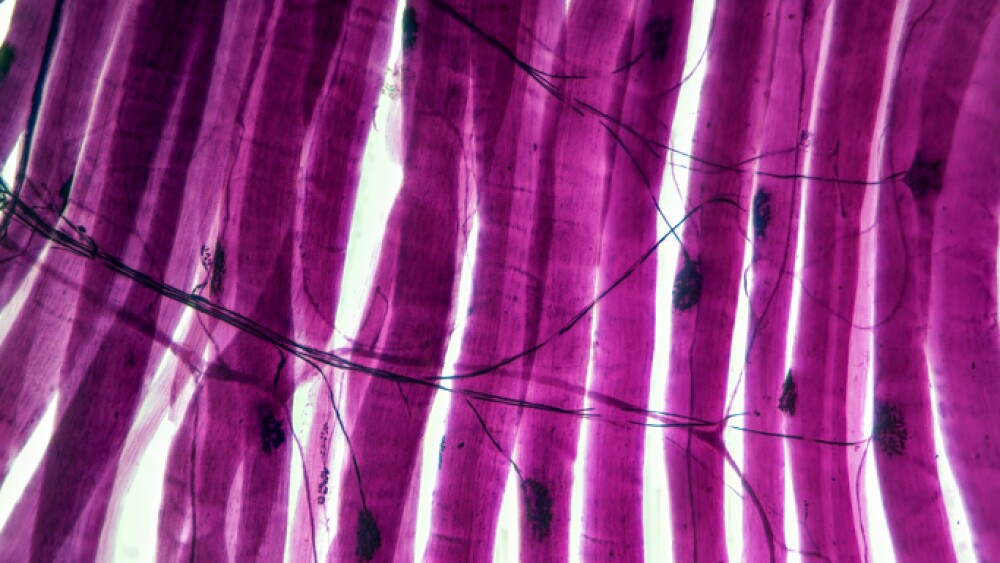- Bayer is committed to advancing treatment in prostate cancer care, showcasing new analyses from its comprehensive clinical trial program for NUBEQA® (darolutamide), which includes the ARANOTE, ARASENS, ARAMON, and ARASTEP trials
- The company also highlights data on XOFIGO® (radium-223 dichloride) in metastatic castration-resistant prostate cancer and biochemically recurrent prostate cancer
ABSTRACTS: 151, 143, 152, 150, 66, TPS432, 183, 180, 81, 99, 101
WHIPPANY, N.J.--(BUSINESS WIRE)--Bayer will present new data from its prostate cancer portfolio at the upcoming American Society of Clinical Oncology Genitourinary (ASCO GU) Cancers Symposium, taking place in San Francisco, California, from February 13-15, 2025. These presentations reinforce Bayer´s commitment to advancing treatments across different stages of prostate cancer.
Data will include a subgroup analysis from the investigational Phase III ARANOTE trial, evaluating the efficacy and safety of NUBEQA® (darolutamide) and androgen-deprivation therapy (ADT) in patients with metastatic hormone-sensitive prostate cancer (mHSPC) by disease volume. Subgroup analyses from the investigational Phase III ARASENS trial will be presented, including evaluating age-related efficacy and safety of NUBEQA plus ADT and docetaxel in patients with mHSPC and an analysis of concomitant granulocyte colony-stimulating factor (G-CSF) use in maintaining an efficacious dose and safe delivery of docetaxel in combination with NUBEQA in patients with mHSPC.
Lead-in phase results will be presented from the investigational Phase II ARAMON trial, investigating NUBEQA monotherapy in patients with castration-sensitive prostate cancer (CSPC) after biochemical recurrence (BCR) and other data to be presented will focus on clinical use and outcomes of androgen-receptor pathway inhibitors triplet therapy for mHSPC. A trial-in-progress update will also be presented for the ongoing investigational Phase III ARASTEP trial investigating NUBEQA plus ADT in patients with high-risk BCR of prostate cancer.
NUBEQA is indicated in the U.S. for the treatment of adult patients with mHSPC in combination with docetaxel and for the treatment of adult patients with non-metastatic castration-resistant prostate cancer (nmCRPC).1
In radiopharmaceuticals, investigator-initiated research will be presented on XOFIGO® (radium-223 dichloride) without ADT in patients with BCR and positron emission tomography (PET) findings in the bones. Investigator-initiated research will be presented evaluating the safety and efficacy of retreatment of metastatic castration-resistant prostate cancer (mCRPC) patients with XOFIGO therapy in daily practice. Data from three Real World Evidence studies, reviewing data from over 30 observational studies, will be presented.
XOFIGO is indicated in the U.S. for the treatment of patients with castration-resistant prostate cancer (CRPC), symptomatic bone metastases and no known visceral metastatic disease.2
Details on selected abstracts from Bayer at the 2025 ASCO GU Cancers Symposium are listed below:
NUBEQA (darolutamide)
- Darolutamide plus ADT in patients with metastatic hormone-sensitive prostate cancer (mHSPC) by disease volume: Subgroup analysis of the phase 3 ARANOTE trial
- Abstract: 151; February 13. 11:25 AM – 12:45 PM PST
- Age-related efficacy and safety of darolutamide plus androgen-deprivation therapy (ADT) and docetaxel in patients with metastatic hormone-sensitive prostate cancer (mHSPC): a subgroup analysis of ARASENS
- Abstract: 143; February 13. 11:25 AM – 12:45 PM PST
- Concomitant G-CSF use in maintaining an efficacious dose and safe delivery of docetaxel in combination with darolutamide in patients with metastatic hormone sensitive prostate cancer (mHSPC): ARASENS, a phase 3 study
- Abstract: 152; February 13. 11:25 AM – 12:45 PM PST
- Darolutamide monotherapy in patients with castration-sensitive prostate cancer (CSPC) after biochemical recurrence (BCR): ARAMON lead-in phase results
- Abstract: 150; February 13. 11:25 AM – 12:45 PM PST
- Clinical use and outcomes of Androgen-Receptor pAthwAy inhibitors Triplet therapy for metastatic hormone-sensitive prostate cancer (ARAAT) – Real World Evidence (RWE)
- Abstract: 66; February 13. 11:25 AM – 12:45 PM PST
- Darolutamide plus androgen-deprivation therapy (ADT) in patients with high-risk biochemical recurrence (BCR) of prostate cancer: A phase 3, randomized, double-blind, placebo-controlled study (ARASTEP) - Trial in Progress (TiP)
- Abstract: TPS432; February 13. 11:25 AM – 12:45 PM PST
XOFIGO (radium-223 dichloride)
- Re-treatment of metastatic castration-resistant prostate cancer patients with radium-223 therapy in daily practice - Investigator-Initiated Research (IIR)
- Abstract: 183; February 13. 11:25 AM – 12:45 PM PST
- Radium 223 without Androgen Deprivation Therapy (ADT) in Patients (Pts) with Biochemically Recurrent Prostate Cancer (BCR) and PET Findings in the Bones - Investigator-Initiated Research (IIR)
- Abstract: 180; February 13. 11:25 AM -12:45 PM PST
- Effectiveness and safety of radium-223 in men with metastatic castration-resistant prostate cancer (mCRPC): A systematic literature review of 48 real-world studies – Real World Evidence (RWE)
- Abstract: 81; February 13. 11:25 AM – 12:45 PM PST
- Real-world treatment patterns and survival in men with metastatic castration-resistant prostate cancer (mCRPC) who previously progressed from metastatic hormone-sensitive prostate cancer (mHSPC) between 2020 to 2023 in the United States – Real World Evidence (RWE)
- Abstract: 99; February 13. 11:25 AM -12:45 PM PST
- Treatment patterns and survival in men with metastatic castration-resistant prostate cancer (mCRPC): A systematic literature review of 35 real-world observational studies – Real World Evidence (RWE)
- Abstract: 101; February 13. 11:25 AM -12:45 PM PST
About NUBEQA® (darolutamide)1
NUBEQA® (darolutamide) is an androgen receptor inhibitor (ARi) with a distinct chemical structure that competitively inhibits androgen binding, AR nuclear translocation, and AR-mediated transcription.
NUBEQA is developed jointly by Bayer and Orion Corporation, a globally operating Finnish pharmaceutical company.
NUBEQA is an androgen receptor inhibitor indicated for the treatment of adult patients with:
- Non-metastatic castration-resistant prostate cancer (nmCRPC)
- Metastatic hormone-sensitive prostate cancer (mHSPC) in combination with docetaxel
IMPORTANT SAFETY INFORMATION
Warnings & Precautions
Ischemic Heart Disease – In a study of patients with nmCRPC (ARAMIS), ischemic heart disease occurred in 3.2% of patients receiving NUBEQA versus 2.5% receiving placebo, including Grade 3-4 events in 1.7% vs. 0.4%, respectively. Ischemic events led to death in 0.3% of patients receiving NUBEQA vs. 0.2% receiving placebo. In a study of patients with mHSPC (ARASENS), ischemic heart disease occurred in 3.2% of patients receiving NUBEQA with docetaxel vs. 2% receiving placebo with docetaxel, including Grade 3-4 events in 1.3% vs. 1.1%, respectively. Ischemic events led to death in 0.3% of patients receiving NUBEQA with docetaxel vs. 0% receiving placebo with docetaxel. Monitor for signs and symptoms of ischemic heart disease. Optimize management of cardiovascular risk factors, such as hypertension, diabetes, or dyslipidemia. Discontinue NUBEQA for Grade 3-4 ischemic heart disease.
Seizure – In ARAMIS, Grade 1-2 seizure occurred in 0.2% of patients receiving NUBEQA vs. 0.2% receiving placebo. Seizure occurred 261 and 456 days after initiation of NUBEQA. In ARASENS, seizure occurred in 0.6% of patients receiving NUBEQA with docetaxel, including one Grade 3 event, vs. 0.2% receiving placebo with docetaxel. Seizure occurred 38 to 340 days after initiation of NUBEQA. It is unknown whether antiepileptic medications will prevent seizures with NUBEQA. Advise patients of the risk of developing a seizure while receiving NUBEQA and of engaging in any activity where sudden loss of consciousness could cause harm to themselves or others. Consider discontinuation of NUBEQA in patients who develop a seizure during treatment.
Embryo-Fetal Toxicity – Safety and efficacy of NUBEQA have not been established in females. NUBEQA can cause fetal harm and loss of pregnancy. Advise males with female partners of reproductive potential to use effective contraception during treatment with NUBEQA and for 1 week after the last dose.
Adverse Reactions
In ARAMIS, serious adverse reactions occurred in 25% of patients receiving NUBEQA vs. 20% of patients receiving placebo. Serious adverse reactions in ≥1% of patients who received NUBEQA included urinary retention, pneumonia, and hematuria. Fatal adverse reactions occurred in 3.9% of patients receiving NUBEQA vs. 3.2% of patients receiving placebo. Fatal adverse reactions in patients who received NUBEQA included death (0.4%), cardiac failure (0.3%), cardiac arrest (0.2%), general physical health deterioration (0.2%), and pulmonary embolism (0.2%). The most common adverse reactions (>2% with a ≥2% increase over placebo), including laboratory test abnormalities, were increased AST, decreased neutrophil count, fatigue, increased bilirubin, pain in extremity and rash. Clinically relevant adverse reactions occurring in ≥2% of patients treated with NUBEQA included ischemic heart disease and heart failure.
In ARASENS, serious adverse reactions occurred in 45% of patients receiving NUBEQA with docetaxel vs. 42% of patients receiving placebo with docetaxel. Serious adverse reactions in ≥2% of patients who received NUBEQA with docetaxel included febrile neutropenia (6%), decreased neutrophil count (2.8%), musculoskeletal pain (2.6%), and pneumonia (2.6%). Fatal adverse reactions occurred in 4% of patients receiving NUBEQA with docetaxel vs. 4% of patients receiving placebo with docetaxel. Fatal adverse reactions in patients who received NUBEQA included COVID-19/COVID-19 pneumonia (0.8%), myocardial infarction (0.3%), and sudden death (0.3%). The most common adverse reactions (≥10% with a ≥2% increase over placebo with docetaxel) were constipation, rash, decreased appetite, hemorrhage, increased weight, and hypertension. The most common laboratory test abnormalities (≥30%) were anemia, hyperglycemia, decreased lymphocyte count, decreased neutrophil count, increased AST, increased ALT, and hypocalcemia. Clinically relevant adverse reactions in <10% of patients who received NUBEQA with docetaxel included fractures, ischemic heart disease, seizures, and drug-induced liver injury.
Drug Interactions
Effect of Other Drugs on NUBEQA – Combined P-gp and strong or moderate CYP3A4 inducers decrease NUBEQA exposure, which may decrease NUBEQA activity. Avoid concomitant use.
Combined P-gp and strong CYP3A4 inhibitors increase NUBEQA exposure, which may increase the risk of NUBEQA adverse reactions. Monitor more frequently and modify NUBEQA dose as needed.
Effects of NUBEQA on Other Drugs – NUBEQA inhibits breast cancer resistance protein (BCRP) transporter. Concomitant use increases exposure (AUC) and maximal concentration of BCRP substrates, which may increase the risk of BCRP substrate-related toxicities. Avoid concomitant use where possible. If used together, monitor more frequently for adverse reactions, and consider dose reduction of the BCRP substrate.
NUBEQA inhibits OATP1B1 and OATP1B3 transporters. Concomitant use may increase plasma concentrations of OATP1B1 or OATP1B3 substrates. Monitor more frequently for adverse reactions and consider dose reduction of these substrates.
Review the Prescribing Information of drugs that are BCRP, OATP1B1, and OATP1B3 substrates when used concomitantly with NUBEQA.
For important risk and use information about NUBEQA, please see the accompanying full Prescribing Information.
About Metastatic Hormone-Sensitive Prostate Cancer
Prostate cancer is the second most common cancer in men and the fifth most common cause of cancer death in men worldwide.3 In 2020, an estimated 1.4 million men were diagnosed with prostate cancer, including almost 300,000 cases in the U.S., and about 375,000 died from the disease worldwide.4,5
At the time of diagnosis, most men have localized prostate cancer, meaning their cancer is confined to the prostate gland and can be treated with curative surgery or radiotherapy. Upon relapse when the disease will metastasize or spread, androgen deprivation therapy (ADT) is the cornerstone of treatment for this hormone-sensitive disease. Approximately 10% of men will already present with mHSPC when first diagnosed.6,7,8 Men with metastatic hormone-sensitive prostate cancer (mHSPC) will start their treatment with hormone therapy, such as ADT, androgen receptor inhibitor (ARi) plus ADT or a combination of the chemotherapy docetaxel and ADT. Despite this treatment, most men with mHSPC will eventually progress to castration-resistant prostate cancer (CRPC), a condition with limited survival.
About XOFIGO (radium Ra 223 dichloride) Injection2
Xofigo is indicated for the treatment of patients with castration-resistant prostate cancer, symptomatic bone metastases and no known visceral metastatic disease.
IMPORTANT SAFETY INFORMATION
Warnings and Precautions:
- Bone Marrow Suppression: In the phase 3 ALSYMPCA trial, 2% of patients in the Xofigo arm experienced bone marrow failure or ongoing pancytopenia, compared to no patients treated with placebo. There were two deaths due to bone marrow failure. For 7 of 13 patients treated with Xofigo bone marrow failure was ongoing at the time of death. Among the 13 patients who experienced bone marrow failure, 54% required blood transfusions. Four percent (4%) of patients in the Xofigo arm and 2% in the placebo arm permanently discontinued therapy due to bone marrow suppression. In the randomized trial, deaths related to vascular hemorrhage in association with myelosuppression were observed in 1% of Xofigo-treated patients compared to 0.3% of patients treated with placebo. The incidence of infection-related deaths (2%), serious infections (10%), and febrile neutropenia (<1%) was similar for patients treated with Xofigo and placebo. Myelosuppression–notably thrombocytopenia, neutropenia, pancytopenia, and leukopenia–has been reported in patients treated with Xofigo.
Monitor patients with evidence of compromised bone marrow reserve closely and provide supportive care measures when clinically indicated. Discontinue Xofigo in patients who experience life-threatening complications despite supportive care for bone marrow failure
- Hematological Evaluation: Monitor blood counts at baseline and prior to every dose of Xofigo. Prior to first administering Xofigo, the absolute neutrophil count (ANC) should be ≥1.5 × 109/L, the platelet count ≥100 × 109/L, and hemoglobin ≥10 g/dL. Prior to subsequent administrations, the ANC should be ≥1 × 109/L and the platelet count ≥50 × 109/L. Discontinue Xofigo if hematologic values do not recover within 6 to 8 weeks after the last administration despite receiving supportive care
- Concomitant Use With Chemotherapy: Safety and efficacy of concomitant
chemotherapy with Xofigo have not been established. Outside of a clinical trial,
concomitant use of Xofigo in patients on chemotherapy is not recommended due to the potential for additive myelosuppression. If chemotherapy, other systemic radioisotopes, or hemibody external radiotherapy are administered during the treatment period, Xofigo should be discontinued - Increased Fractures and Mortality in Combination With Abiraterone Plus Prednisone/Prednisolone: Xofigo is not recommended for use in combination with abiraterone acetate plus prednisone/prednisolone outside of clinical trials. At the primary analysis of the Phase 3 ERA-223 study that evaluated concurrent initiation of Xofigo in combination with abiraterone acetate plus prednisone/prednisolone in 806 asymptomatic or mildly symptomatic mCRPC patients, an increased incidence of fractures (28.6% vs 11.4%) and deaths (38.5% vs 35.5%) have been observed in patients who received Xofigo in combination with abiraterone acetate plus prednisone/prednisolone compared to patients who received placebo in combination with abiraterone acetate plus prednisone/prednisolone. Safety and efficacy with the combination of Xofigo and agents other than gonadotropin-releasing hormone analogues have not been established
- Embryo-Fetal Toxicity: The safety and efficacy of Xofigo have not been established in females. Xofigo can cause fetal harm when administered to a pregnant female. Advise pregnant females and females of reproductive potential of the potential risk to a fetus. Advise male patients to use condoms and their female partners of reproductive potential to use effective contraception during and for 6 months after completing treatment with Xofigo
Administration and Radiation Protection: Xofigo should be received, used, and administered only by authorized persons in designated clinical settings. The administration of Xofigo is associated with potential risks to other persons from radiation or contamination from spills of bodily fluids such as urine, feces, or vomit. Therefore, radiation protection precautions must be taken in accordance with national and local regulations
Fluid Status: Dehydration occurred in 3% of patients on Xofigo and 1% of patients on placebo. Xofigo increases adverse reactions such as diarrhea, nausea, and vomiting, which may result in dehydration. Monitor patients’ oral intake and fluid status carefully and promptly treat patients who display signs or symptoms of dehydration or hypovolemia
Injection Site Reactions: Erythema, pain, and edema at the injection site were reported in 1% of patients on Xofigo
Secondary Malignant Neoplasms: Xofigo contributes to a patient’s overall long-term cumulative radiation exposure. Long-term cumulative radiation exposure may be associated with an increased risk of cancer and hereditary defects. Due to its mechanism of action and neoplastic changes, including osteosarcomas, in rats following administration of radium-223 dichloride, Xofigo may increase the risk of osteosarcoma or other secondary malignant neoplasms. However, the overall incidence of new malignancies in the randomized trial was lower on the Xofigo arm compared to placebo (<1% vs 2%; respectively), but the expected latency period for the development of secondary malignancies exceeds the duration of follow-up for patients on the trial
Subsequent Treatment With Cytotoxic Chemotherapy: In the randomized clinical trial, 16% of patients in the Xofigo group and 18% of patients in the placebo group received cytotoxic chemotherapy after completion of study treatments. Adequate safety monitoring and laboratory testing was not performed to assess how patients treated with Xofigo will tolerate subsequent cytotoxic chemotherapy
Adverse Reactions: The most common adverse reactions (≥10%) in the Xofigo arm vs the placebo arm, respectively, were nausea (36% vs 35%), diarrhea (25% vs 15%), vomiting (19% vs 14%), and peripheral edema (13% vs 10%). Grade 3 and 4 adverse events were reported in 57% of Xofigo-treated patients and 63% of placebo-treated patients. The most common hematologic laboratory abnormalities in the Xofigo arm (≥10%) vs the placebo arm, respectively, were anemia (93% vs 88%), lymphocytopenia (72% vs 53%), leukopenia (35% vs 10%), thrombocytopenia (31% vs 22%), and neutropenia (18% vs 5%)
Please see the full Prescribing Information for Xofigo (radium Ra 223 dichloride).
About Oncology at Bayer
Bayer is committed to delivering science for a better life by advancing a portfolio of innovative treatments. The oncology franchise at Bayer includes six marketed products and several other assets in various stages of clinical development. Together, these products reflect the company’s approach to research, which prioritizes targets and pathways with the potential to impact the way that cancer is treated.
About Bayer
Bayer is a global enterprise with core competencies in the life science fields of health care and nutrition. In line with its mission, “Health for all, Hunger for none,” the company’s products and services are designed to help people and the planet thrive by supporting efforts to master the major challenges presented by a growing and aging global population. Bayer is committed to driving sustainable development and generating a positive impact with its businesses. At the same time, the Group aims to increase its earning power and create value through innovation and growth. The Bayer brand stands for trust, reliability and quality throughout the world. In fiscal 2023, the Group employed around 100,000 people and had sales of 47.6 billion euros. R&D expenses before special items amounted to 5.8 billion euros. For more information, go to www.bayer.com.
© 2025 Bayer
BAYER, the Bayer Cross, NUBEQA and XOFIGO are registered trademarks of Bayer.
Find more information at www.pharma.bayer.com
Our online press service is just a click away: www.bayer.us/en/newsroom
Follow us on Facebook: http://www.facebook.com/pharma.bayer
Follow us on X: https://X.com/BayerUS
Forward-Looking Statements
This release may contain forward-looking statements based on current assumptions and forecasts made by Bayer management. Various known and unknown risks, uncertainties and other factors could lead to material differences between the actual future results, financial situation, development or performance of the company and the estimates given here. These factors include those discussed in Bayer’s public reports which are available on the Bayer website at www.bayer.com. The company assumes no liability whatsoever to update these forward-looking statements or to conform them to future events or developments.
References
- NUBEQA® (darolutamide) [Prescribing Information]. Whippany, NJ: Bayer HealthCare Pharmaceuticals, Inc.; October 2023.
- XOFIGO® (radium Ra 223 dichloride) Injection [Prescribing Information]. Whippany, NJ: Bayer HealthCare Pharmaceuticals, Inc.; October 2024.
- Hyuna S et al. Ca Cancer J Clin 2021; 71:209–249.
- Prostate Cancer: Statistic. Cancer.Net. https://www.cancer.net/cancer-types/prostate-cancer/statistics. September 2024.
- American Cancer Society. Cancer Facts & Figures 2024. https://www.cancer.org/research/cancer-facts-statistics/all-cancer-facts-figures/2024-cancer-facts-figures.html. September 2024.
- Piombino C et al. Cancers (Basel). 2023 Oct 11;15(20):4945.
- Helgstrand JT et al. Cancer. 2018;124(14):2931-2938.
- Buzzoni C et al. Eur. Urol. 2015;68:885–890.
Contacts
Media Contact:
Polina Miklush, Tel + 862.431.8817
Email: polina.miklush@bayer.com






